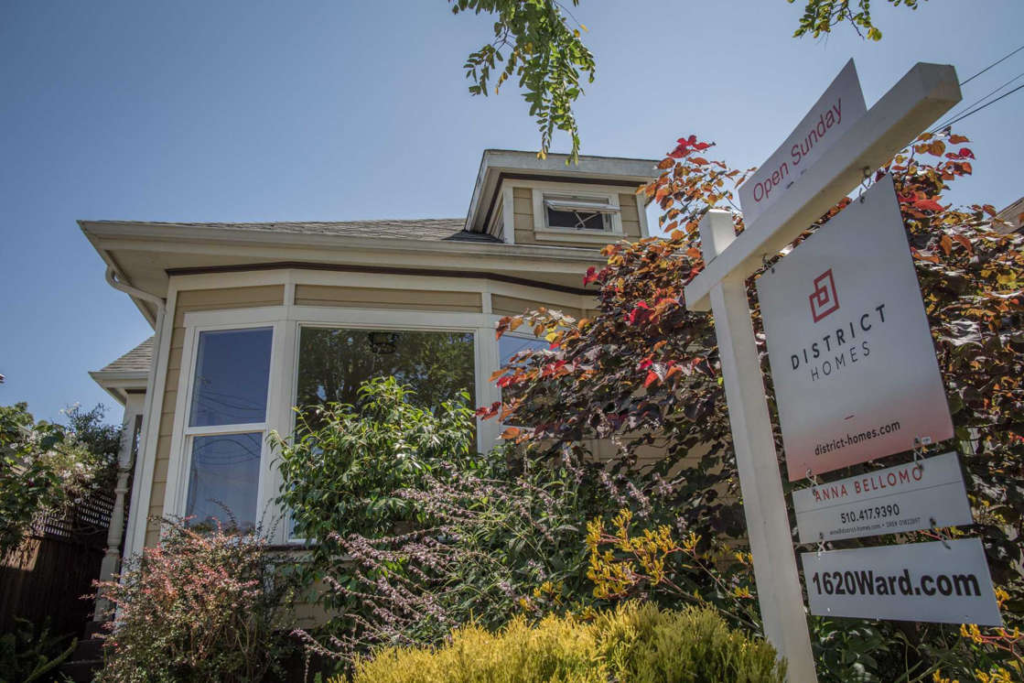加州房市要变天?州长连签三法案 “再见了, 大后院”
文章来源: 华人生活网
9/22/2021

加州州长刚刚完成了罢免的程序,如今顺利连任,连续签署了SB 8、SB 9、SB 10三部法案。
该法案将正式允许一些社区的单一家庭土地上建造更多的多家庭住宅和小型公寓建筑。
这是否意味着火热的加州房市要变天了呢?
在三个法案中,争议最大的就是SB9法案,该法案允许业主在单户住宅地块上建造复式住宅(duplex),或将地块一分为二,这意味着一块地最多可以建出四个单元。法案不仅允许,在真正实施上会要求地方市府批准屋主在自己的单一家庭地块上建出四个单元来。

Tel: 551-580-4856 | Email: F.WINNIE.S@GMAIL.COM
该法案带来的影响可能会大大增加全州的房屋密度和供应量,也就是传统意义上的绿地消失了,变成了密密麻麻的房子。该法案在参议会以28:7票通过,在众议会以45:19票通过。
纽森在一份声明中表示,希望为加州创建更多经济适用房,缓解日益膨胀的住宅负担力危机,让大家还能有一个“加州梦”。
根据估计,S.B. 9法案将在加州现有社区基础上增加70万住宅!这对于寸土寸金的地段来说,不是个小数目。
纽森写道:要对这场危机产生有意义的影响,需要大胆的投资、跨部门的强有力合作,以及领导人和社区的政治勇气来做正确的事情,并为所有人建造住房。
虽然听起来利用土地建设更多的房子是缓解住房压力最有效的办法,但是也有不少民众认为,政府此举并不目的单纯。此前已经有不少组织和民众抗议,呼声最大的是认为:SB9法案是以牺牲加州普通民众的生活质量为代价,来安置游民,同时对于有钱的房产投机者来说又会借此赚给盆满。

还有一些政府反对,认为这些法案僭越地方对规划和分区的控制。早先圣盖博谷27城市曾联名致信州长,希望他否决这些法案,连洛杉矶市议会上月也表示反对。加州城市联盟(The California League of Cities)表示对纽森的决定深感失望,称其为自上而下的授权,无视当地的声音和决策。

SB 8法案是将一条现行法律的2025年最后期限再延长五年,因此在2030年之前,该法将限制地方政府“降级地目”(downzone)的能力,即减少地目密度的能力。该法案在州两院赢得两党大力支持,最终以30-3票和67-11票通过。
SB 10法案将为交通和就业机会丰富的地区,开发小型公寓楼铺平道路。该案允许城市或县通过法令,对于在一个地块上开发多达十个单元的建案申请,其批准流程可以简化。这对房屋开发者来说无疑是好消息,但地方政府和邻里协会认为这是对邻里性质的威胁。参议会以28票对六票通过,众议会以44票对12票通过。
Bay Area home prices dropped in July. Is COVID buying spree over?
By Lauren Hepler
8/22/2021
Last month, the median sale price for a Bay Area house was $1.3 million. It took about eight days for most homes to be snatched up in Santa Clara County. And just last week, a Walnut Creek four-bedroom still badly charred by a fire sold for $850,000 after attracting 13 offers.

Despite it all, a new report by the California Association of Realtors suggests that the region’s housing market may be leveling off after months of record-breaking prices, bidding wars and ever-increasing anxiety about unaffordability.
“The market is kind of normalizing after having been just so imbalanced for such a long time,” said Jordan Levine, the association’s vice president and chief economist. “We do expect that the pace of home sales and the price of home sales will moderate.”
The median cost of a single-family home in the Bay Area dipped 3.6% in July compared to the previous month, the report found, and prices declined or plateaued in all but two of the region’s nine counties. The number of homes sold last month compared to June dropped significantly in several counties, including a 26% decline in Napa County and a 21% dip in San Francisco.
The biggest regional price drop in July was a 7.7% decrease in Sonoma County, to a median $761,700 sale price, followed by a 7.3% dip in San Mateo County to $2.1 million. Prices dropped 5% in San Francisco, to a median $1.9 million, and stayed flat in Alameda County at $1.3 million.
Still, all price changes are relative in one of the world’s most expensive housing markets. July’s Bay Area home prices were still 24% higher than the same time last summer. And while the pandemic changed the dynamic in many local housing markets, California home prices have long been boosted by more systemic factors like restrictive zoning laws, uneven property taxes and a consistent lack of new housing.
Linda Ngo has seen how these cycles play out before. The Coldwell Banker real estate consultant grew up in Marin and found herself at the center of the exodus from San Francisco last year, when Millennials and other clients were moving out of the city and into homes with offices and outdoor space in Oakland, Marin, Livermore and beyond.

In the last few months, she’s seen another shift. Where homes in Marin were regularly going for 15% or more over the asking price as recently as this spring, many are now going for more like 5% over. It was rare a few months ago to see houses last more than about a week on the market, but some are now available for 20 days or more.
“I am seeing that demand soften a little bit,” Ngo said. “Now that companies are talking about having their employees come back to the office part time, people are realizing that maybe they do need to go back to the city.”
Across California, demand for houses continues to outpace the supply of homes for sale, with 70% of homes sold last month going above the asking price, the California Association of Realtors report found. Another recent analysis by mortgage site HSH.com concluded that it takes an annual income of $254,532 in San Jose and $208,015 in San Francisco to afford the average mortgage — far more than the $129,444 needed in San Diego or $86,833 in Portland.
All the housing competition in recent months has also highlighted glaring inequities in the Bay Area market. Backlash to homeless encampments and concern about renter evictions are both hitting a boiling point as emergency pandemic programs wind down. Some people who already own homes have also spoken out about problems like potential racial bias in determining the value of a house.
One thing Levine will be gauging in the coming months is whether more homes go up for sale, and if familiar seasonal buying patterns — busier in the summer, calmer in the winter — return after being derailed during pandemic shutdowns. One wild card, he said, is what may happen with the rise of the delta variant of the coronavirus.
“It seems like every time the public health numbers get worse, folks get more interested in housing,” he said. “Those suburban markets in particular start to punch above their weight.”
Ngo said she’s still seeing a “domino effect,” where former San Francisco dwellers move to houses in places like Oakland and help boost the prices there, in turn encouraging existing homeowners to sell and take the proceeds to more affordable places like the Sacramento area.
Lately, Ngo has also been seeing more interest from investors as ordinary home buyers grapple with fatigue from unfruitful searches. Some are just waiting to see what happens, hoping there’s still a bigger dip to come.
“A lot of people think there’s no way this market can keep going like this,” Ngo said. “But I think they’re wrong.”
Southern California home prices hit a new record. Is a slowdown on the horizon?
6/22/2021

Southern California home prices soared in May, hitting another all-time high, though some data are starting to point to a potential slowdown in demand.
The six-county region’s median sales price rose a whopping 24.7% from May 2020 to a record $667,000 last month, according to data released Tuesday by data firm DQNews.
Sales also surged from a year earlier.
The big leap in numbers from a year earlier is partly due to a once-in-a-lifetime comparison.
The data reflect closed sales, meaning the 2020 data covered mostly deals that opened escrow during March and April 2020 — the height of the coronavirus lockdowns. At the time, sales had plunged and price growth slowed.
As those lockdowns eased, the housing market roared back to life both locally and nationally, spurred by record low mortgage rates and a desire for more space during the pandemic. The number of investor sales is also on the rise, as deep-pocketed individuals and companies look to acquire single-family houses to rent out or renovate.
Median home prices in the region have risen by double digits for 10 consecutive months and new records are being set both regionally and locally.
- In Los Angeles County, the median home price rose 25% to a record $775,000 in May, while sales climbed 117%.
- In Orange County, the median home price rose 19.3% to a record $895,000, while sales climbed 113.4%.
- In Riverside County, the median home price rose 22.5% to a record $502,250, while sales climbed 81.7%.
- In San Bernardino County, the median home price rose 16.8% to $432,000, while sales climbed 61%.
- In San Diego County, the median home price rose 22.9% to a record $725,000, while sales climbed 81.7%.
- In Ventura County, the median home price rose 20.9% to a record $701,500, while sales climbed 128.7%.
It’s unclear how long such rapid increases will continue, and many buyers worry they are being priced out of the market.
Selma Hepp, deputy chief economist with CoreLogic, said she expects home-price appreciation to slow from today’s torrid levels, though she doesn’t see price declines on the horizon.
Some data are pointing in the direction of a potential slowdown. An index of national home-buyer demand from real estate brokerage Redfin has fallen 14% from a peak in April. The index factors in requests for home tours and other services the company provides.
The number of home sales entering escrow is also falling nationally and in L.A. County, but those rates are still above the comparable time period in 2019 and 2018, in addition to 2020, according to Redfin.
Taylor Marr, lead economist with Redfin, said the apparent slowdown is slight and might mean buyers will just have an easier time getting their offers accepted without having to waive contingencies, which allow buyers to back out of a deal without penalties if an appraisal doesn’t come through or an inspection turns up a problem.
“It appears that a healthier market may finally be on the horizon even if it doesn’t come with a discount,” Marr said.
This story originally appeared in Los Angeles Times.
Californians are headed to Texas. Why more people are moving to Lone Star State
Home prices are a big driver for tens of thousands of Californians to pack up and head to Texas, researchers say.
By Jeff Ehling
4/17/2021
The data proves Californians are leaving the Golden State and buying homes in the Lone Star State. See why and how many have moved here.
Californians are headed to Texas.
Researchers at Rice University’s Kinder Institute for Urban Research in Houston, Texas say home prices are a big driver.
It’s causing tens of thousands of Californians to seek out new places to live in the Lone Star State.
When Bill Fulton was recently asked by business leaders if Golden State residents were really coming to Texas in large numbers, he went to work to find the answer.
As the director of the Kinder Institute for Urban Research at Rice University, Fulton analyzed the numbers.
He found, on average, about 35,000 to 40,000 Texans move to California every year, but recently a noticeable number of people are doing just the opposite.
In 2018 and 2019, about 80,000 people a year made the move from California to Texas.
The Kinder Institute found as housing prices go up in California, there is a steady migration to Texas.
It has a real-world impact on housing prices in the Lone Star State and those who were born and raised there when they try to find an affordable place to live.
“The consequences it does have is the people who already live in Texas who maybe do not have a lot of home equity and are not used to those California home prices, they may have a more difficult time buying a house, at least the house they want to buy in the place they want to buy,” said Fulton
That means lower income families may have to move further away from the city center to find affordable housing, making their commutes longer and more expensive.
As for whether or not those moving Californians could turn Texas blue, researchers say there doesn’t seem to be enough migration to make that happen on its own.
Jun 9, 2020
Dec 3, 2020
Is a Housing Market Crash Possible in 2021?
By Mark Mathis
4/15/2021

With the real estate market experiencing surging prices, scant inventories and a backlog of new home construction, many consumers are wondering if what’s gone up must come back down—in other words, are we headed for another housing market crash? Let’s take a closer look.
Think Back to the Great Recession
The unforeseen housing market crash 15 years ago ignited a worldwide recession. Fueled by low interest rates, loose mortgage-lending standards and the nation’s unshakeable faith in homeownership, home values rose at record rates year-after-year. When the housing bubble burst, roughly nine million families lost their homes to foreclosure or short sale between 2006 and 2014. Housing values plunged 30% or more, homeowners lost a collective $7 trillion and it took nearly a decade for most markets to recover. Even today, several real estate markets have not fully recovered.
With the robust market activity we’ve seen lately, could there be a market crash in the near future? The short answer is “not likely.” Today’s market book cannot be sustained completely, but a crash as serious as the one from 15 years ago is unlikely because of a few important factors.
Factor No. 1: More Stringent Lending Standards
Loose mortgage lending practices ultimately brought down some of the nation’s largest banks and mortgage companies. The fallout forced Congress and federal regulators to make significant adjustments that have fundamentally changed how mortgage lending is regulated.
Since then, standards have been raised and the process of obtaining a mortgage is now more transparent. The “anyone can get one” loans of the past are illegal; now borrowers undergo stricter income, credit and asset checks. An entirely new regulatory agency, the Consumer Financial Protection Bureau, was created to enforce this new regulatory framework. Lenders who do not comply with these standards may face heavy penalties.
As a result, the housing finance marketplace is now more robust and safer than it was 15 years ago. Any dip in the housing market will be cushioned by these stricter regulations.
Factor No. 2: Pandemic Mortgage Forbearance
When the housing market crashed in 2007, the influx of foreclosures pumped housing supply into areas with falling prices and weak labor markets, while also preventing recently foreclosed borrowers from re-entering the market as buyers. According to the Federal Reserve, foreclosures during a time of high unemployment could depress prices, plunging homeowners across the country deeper into negative equity.
However, in the pandemic era, the effects of mass unemployment bear little resemblance to the Great Recession, thanks in large part to forbearance programs that have allowed homeowners to postpone their monthly mortgage payments without suffering penalties.
As of early March 2021, 2.6 million homeowners’ mortgages were in such forbearance plans. As the pandemic economy has slowly recovered, many homeowners have resumed their employment, and thus their home payments. According to CoreLogic, by the end of 2020, overall mortgage delinquencies declined 5.8% due to the forbearance program. The share of mortgages 60 to 89 days past due declined to 0.5%, lower than 0.6% in December 2019.
Housing Market Crash
It’s worth noting that serious delinquencies—defined as 90 days or more past due, including loans in foreclosure—increased when owners who owed large amounts left forbearance. By year end 2020, the serious delinquency rate was 3.9%, up from 1.2% in December 2019.
Factor No. 3: Most Homeowner’s Cushion—Equity
Equity is the difference between the current market value of your home and the amount you owe on it. In other words, it’s the portion of your home’s value that you actually own. Equity can be an incentive to stay in your home longer; if prices rise—something we’ve seen almost universally across the country in recent months—your equity increases, too.
Why does this matter? Simply put, higher levels of equity cushion homeowners from default when home values fall.
Over the past decade, American homeowners have enjoyed housing stability and growth, building up large home equity reserves. In the third quarter of 2020, the average family with a mortgage had $194,000 in home equity, and the average homeowner gained approximately $26,300 in equity over the course of the year. In contrast, 2009 saw nearly a quarter of the nation’s mortgaged homes valued for less than the amount their owners actually owed on those mortgages.
Factor No. 4: Price Growth Will Slow Down, but Continue
The sales boom followed the outbreak of the COVID-19 and surprised many real estate economists. Like most other business sectors, real estate was expected (if not required in many locations) to lock down. But by mid-April, sales were soaring as buyers, many of them millennials, took advantage of record-low mortgage interest rates. Through the remainder of 2020, rates remained below 3%, and existing home sales reached their highest level in 14 years.
A Moving Target
While no one can say for sure what will happen with the real estate sector, most experts are confident that we’ll experience a market dip, but certainly not a crash. In the meantime, there’s plenty of work available for motivated real estate professionals. Find out how Homes.com can help you connect with the current market of active buyers and sellers here!
Source: https://rismedia.com/2021/03/25/housing-market-crash-possible-2021/
Flat-Fee MLS Listing Service in Northern VA

Helping For Sale by Owner (FSBO) & For Rent by Owner (FRBO)
DIY Landlord – Renting out Properties Safer and Quicker!
By David Chen
4/15/2021
Q. We purchased our first home some years ago, and are about to move to another home. We are considering to keep our first home as an income property. We heard of the free ads on CRAIGSLIST and zillow.com, but some landlord friends told us it could be a challenge to find qualified tenants through CRAIGSLIST and zillow.com. Is there any way to rent our property out quicker and safer with minimum cost? We are the kind of persons who would like to try things ourselves, and have some spare time.
A. You may have already done the initial research and have figured out the range of monthly rent of your property.
If the monthly rent is low such as $1600.00 or below, you may want to do it through CRAIGSLIST, https://postlets.com/, zillow.com, or similar web sites. The renters interested in the low-priced rentals may not go to the Realtors community for assistance.
If the monthly rent is $1600.00 or above, you may want to consider listing your rental on brightmls.com for the Realtors community to market it for you.
Bright MLS is made up of nine forward thinking MLSs (43 Associations) in the Mid-Atlantic region who put aside their differences and came together with a shared vision to help solve MLS market overlap and empower everyone to get more out of the MLS. Bright will serve parts of 6 states plus Washington, D.C. encompassing 85,000 real estate professionals who serve over 20 million consumers and facilitate approximately 250,000 transactions a year that are valued at more than $70 billion.
Dozens of public real estate websites (such as: zillow.com, redfin.com, brightmlshomes.com, etc.) pull data from brightmls.com through syndication. In a few hours, your listing will show up on dozens of websites and will get the maximum exposure. It is a lot quicker and safer finding qualified tenants than doing it through CRAIGSLIST and zillow.com. You may talk with a Realtor for assistance. Please be aware some Realtors take rental jobs, some don’t.
Over the years I have helped some landlords in the community renting their properties out with very low cost. A popular arrangement is to help the landlords ‘DIY’, which has been working well for those experienced landlords.
The good side of ‘DIY’ is that the landlords can ‘screen’ the potential tenants from the very beginning, have 100% control of the whole process, and enjoy the feeling of “on top of things”.
If you prefer minimum service, I can help you ‘DIY’:
1. I provide CMA, list your rental on brightmls.com, put a realtor’s lockbox at the front door if needed, provide the access log (if needed), support you through the whole process.
I charge a flat fee for the minimum service.
2. If you would like me to prepare the lease or review the lease, there is another reasonable flat fee. This service is optional.
3. You answer phone calls, work with the tenant (if the tenant doesn’t have an agent) or the tenant’s agent, run credit check, verify employment, check references, etc.. You pay the tenant’s agent (if there is one) directly on the move-in date – usually 25% of first-month rent.
If you need full-service, the commission is first-month rent – which includes the commission to be paid to the tenant’s agent.
If you need any customized service (between minimum service and full-service), we can work out an agreement.
Some information:
CMA stands for Comparable (some called Competitive) Market Analysis, that will help you determine the market value of your property for sale or for rent.
I use Sentry-key lockbox. Any Realtor with membership of NVAR (Northern Virginia Association of Realtors) or any other VA Realtors association can access and show the property.
The access log tells when the agents enter the property and their contact info. which can help you follow up with the agents.
If you like the DIY experience, I would recommend you to use the minimum service.
Please feel free to reach me if you need any assistance.
—
David Chen
Realtor (Licensed in VA) | Neighborhood Specialist (McLean, Falls Church, Vienna)
Libra Realty, LLC
dchenj@gmail.com
703-395-5406
WeChat ID: dchenj2015

Last update: 4/15/2021
Websites that will show your flat fee mls listings
4/15/2021
Almost all real estate websites that offer the ability to search brokerage listings use a data feed from the MLS called Internet Data Exchange (IDX) to pull in listing data. Depending on the number of sites tapping into your MLS, your listing could appear on hundreds of websites. We do not control the content of any of the websites listed below. updated periodically & subject to change at any time Here are some examples of national websites by area that pull listings from the MLS:
This block contains unexpected or invalid content.Attempt Block Recovery
- Zillow
- Trulia
- Move.com
- MSN.com
- REALTOR.com
- REMAX.com (in markets where they have an office)
- ZipRealty.com (in markets where they have an office)
- Yahoo.com / Prudential (in markets where they have an office)
- Google Base
- Redfin
- Yahoo Classifieds
- AOL Real Estate
- HomeGain
- Lycos
- Oodle
- Hotpads
- HomeSeekers
- ColdwellBanker.com
- Cenutry21.com
- HouseFront
- CondoQuickFind
Here are just a few examples of local media websites that pull listings from the MLS in their area:
- AZCentral.com (Phoenix, Arizona)
- Chron.com (Houston, Texas)
- DallasNews.com (Dallas/Fort Worth, Texas)
- DenverPost.com (Denver, Colorado)
- LATimes.com (Los Angeles, California)
- MySA.com (San Antonio, Texas)
- RGJ.com (Reno, Nevada)
- SignOnSanDiego.com (San Diego, California)
- StarBulletin.com (Honolulu, Hawaii)
- Tucson.com(Tucson, Arizona)
Here are just a few examples of local brokerage websites that pull listings from the MLS in their area:
- BishopRealty.com (Payson, Arizona)
- Boulderco.com (Boulder, Colorado)
- C21MoneyWorld.com (Las Vegas, Nevada)
- ColdwellBanker-Idaho.com (Coeur d’Alene, Idaho)
- Ebby.com (Dallas, Texas)
- Floberg.com (Billings, Montana)
- LongRealty.com (Tucson, Arizona)
- SantaFeSIR.com (Santa Fe, New Mexico)
- TB.com (Spokane, Washington)
Additionally, here are just a few examples of local REALTOR® Boards or MLS’s that have a public view portal. (Not all boards have this feature):
- ABQREALTORS.com (Albuquerque, New Mexico)
- AlaskaRealEstate.com (Anchorage, Alaska)
- AustinHomeSearch.com (Austin, Texas)
- HAR.com (Houston, Texas)
- HavasuRealtors.com (Lake Havasu City, Arizona)
- HICentral.com (Honolulu, Hawaii)
- mlslistings.com (San Jose, California)
- SFAR.com (Santa Fe, New Mexico)
- TARMLS.com (Tucson, Arizona)
These are just examples. Your listing could literally show up at hundreds of other websites.
Source: https://www.congressrealty.com/Flat-Fee-MLS-Listings/Sites-with-Listings/default.aspp




